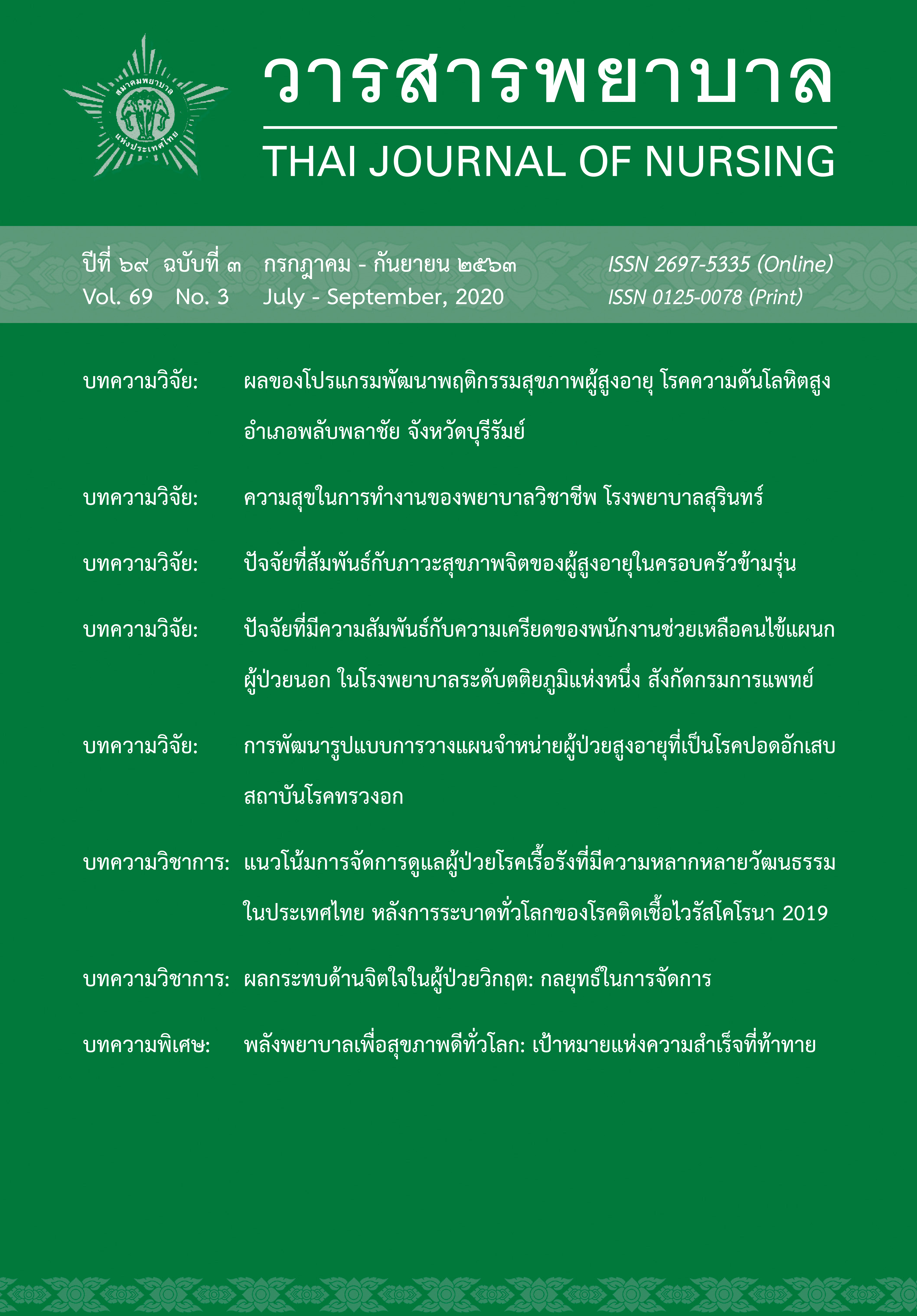Joy at work of professional nurses in Surin Hospital
Main Article Content
Abstract
The purposes of this mixed-methods research were: 1) to study joy at work of professional nurses in Surin Hospital, 2) to compare joy at work of professional nurses classified by departments, 3) to investigate factors related to their joy at work and 4) to explore a guideline for creating their joy at work. The sample of 254 nurses, was selected using systematic random sampling. Research tools comprised: 1) a joy at work questionnaire based on Warr (2007). It was approved content validity (0.60-1.00) and reliability coefficient was 0.88. 2) A question guideline was used for focus group discussion. Data were analyzed by descriptive statistics, one-way ANOVA, and content analysis. The results showed as follows. 1) Overall joy at work of professional nurses was at the high level. 2) Joy at work among professional nurses classified by departments illustrated that there was no significant difference. 3) There were two related factors of their joy at work: 1) Personal factors, and 2) environmental factors embraced opportunity for personal control, opportunity for job skill use, job goal, job variety, proper compensation, job advancement, physical security, value social position, supportive supervision, equity, and colleague relationship. 4) the guideline for creating their joy at work contained 4 aspects as follows: 1) Organization e.g. built up enjoyable organizational culture, 2) administrators e.g. promoted self-development personally and regularly, 3) personnel e.g. paid attention to their job and learn continuously, and 4) colleagues e.g. created good relationship in organization.
Article Details
References
กฤษดา แสวงดี. (2560). วิกฤติขาดแคลนพยาบาลวิชาชีพในหน่วยบริการสุขภาพของสำนักงาน
ปลัดกระทรวงสาธารณสุข: ข้อเสนอเชิงนโยบาย. วารสารวิชาการสาธารณสุข, 26(2),
-456.
ชุติมา ปัญญาพินิจนุกูร, กลีบแก้ว จันทร์หงษ์, และปรัศนี สมิธ. (2555). การเสริมสร้างความสุข
ในการทำงานเพื่อส่งเสริมความยึดมั่นผูกพันต่อองค์กรของอาจารย์ในวิทยาลัยพยาบาลบรมราชชนนี
กรุงเทพ. วารสารพยาบาลกระทรวงสาธารณสุข, 22(2), 11-23.
ถิตรัตน์ พิมพาภรณ์, และธีระวัฒน์ จันทึก. (2559). ความสุขในการทำงาน: ความท้าทายของ
การจัดการทรัพยากรมนุษย์ในอุตสาหกรรมบริการ. วารสารมนุษยสังคมปริทัศน์, 18(2), 113-126.
บุญใจ ศรีสถิตย์นรากูร. (2555). การพัฒนาและตรวจสอบคุณภาพเครื่องมือวิจัย: คุณสมบัติการวัด
เชิงจิตวิทยา. กรุงเทพมหานคร: โรงพิมพ์แห่งจุฬาลงกรณ์มหาวิทยาลัย.
เรมวล นันท์ศุภวัฒน์, อรอนงค์ วิชัยคำ, และอภิรดี นันท์ศุภวัฒน์. (2557). ความสัมพันธ์ระหว่างชั่วโมง
การปฏิบัติงานเกินเวลาของพยาบาล และผลลัพธ์ด้านผู้ป่วย พยาบาลและองค์กรในโรงพยาบาล
ทั่วไป. พยาบาลสาร, 41(4), 58-69.
สุภางค์ จันทวานิช. (2556). วิธีการวิจัยเชิงคุณภาพ (พิมพ์ครั้งที่ 21). กรุงเทพมหานคร: สำนักพิมพ์
แห่งจุฬาลงกรณ์มหาวิทยาลัย.
.
สุรเดช ศรีอังกูร. (2558). ลด ละ เลิก วัฒนธรรมการตำหนิ กล่าวโทษ Blame Culture เพื่อสร้าง
ความปลอดภัย. สืบค้นเมื่อ 6 มิถุนายน 2560, จาก https://www.rama.mahidol.ac.th/
cqs/sites/default/files/public/Blame%20culture%20-%20Suradet%20Sriangkoon.pdf
Kerns, C. D. (2008). Putting performance and happiness together in the workplace. Graziadio Business
Review, 11 (1). Retrieved June 6, 2017, https://gbr.pepperdine.edu/2010/08/putting-
performance-and-happiness-together-in-the-workplace/
Veenhoven, R. (1984). Condition of happiness. Retrieved May 1, 2017, จาก
Warr, P. (2007). Work, happiness, and unhappiness. Washington, DC: Lawrence Erlbaum Associates.
Manpower group. (2017). การสร้างความสุขในที่ทำงาน. สืบค้นเมื่อ 1 มิถุนายน 2560, จาก
www.manpowerthailand.com


